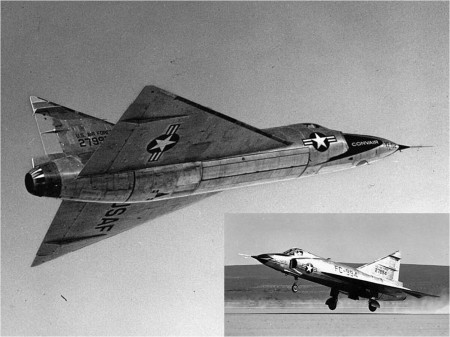Fifty-nine years ago this week, the USAF/Convair YF-102 Delta Dagger all-weather interceptor prototype flew for the first time in the skies over Edwards Air Force Base. Convair test pilot Richard Lowe “Dick” Johnson was at the controls of the delta-winged, turbojet-powered aircraft.
The F-102 Delta Dagger was the third Century Series aircraft to enter production. Known as the Deuce, the aircraft was designed as an all-weather, supersonic interceptor. Its mission was protect the continental United States from attack by Soviet strategic bombers. The type’s primary armament consisted of a bevy of six (6) internally-carried Falcon air-to-air missiles.
The Deuce was the product of the 1954 Interceptor Project begun by USAF in the late 1940’s. A direct descendant of Convair’s pioneering XF-92A Dart, the Delta Dagger was that company’s second delta wing-configured, turbojet-powered aircraft. Convair’s clear preference for the delta wing planform was destined to become a company trademark throughout the 1950’s. Arguably the highest expression of this design feature came in the form of the Convair F-106 Delta Dart and B-58A Hustler supersonic aircraft.
First flight of the first YF-102 protype (S/N 52-7994) took place on Saturday, 24 October 1953. The aircraft was powered by a Pratt and Whitney J57 turbojet rated at 14,500 lbs of sea level thrust in afterburner. Unfortunately, this flight test and several that closely followed shocked Convair aircraft designers with the revelation that the Deuce could not fly supersonically. The aircraft simply generated too much transonic wave drag.
Faced with the gravity of the situation, Convair quickly went to work to markedly improve the performance of its troubled delta wing steed. Thanks largely to a fortuitously-timed discovery by NACA aerodynamicist Richard Whitcomb, the Delta Dagger’s performance potential would eventually be realized. Whitcomb’s aerodynamic breakthrough was referred to as the Transonic Area Rule.
Briefly, Richard Whitcomb discovered that the transonic wave drag of an aircraft could be reduced by ensuring a smooth variation of the aircraft’s nose-to-tail cross-sectional area development. Elimination of abrupt changes in this distribution corresponded to a reduction in the strength of localized shock waves.
Combined with an uprated version of the Deuce’s Pratt and Whitney J57 powerplant, application of Whitcomb’s Transonic Area Rule resulted in a sleeker and faster aircraft known as the YF-102A. While it took over a year to effect the necessary changes, the YF-102A easily achieved supersonic flight on Tuesday, 21 December 1954.
The Convair F-102 Delta Dagger went on to a fine operational career lasting 20 years with the United States Air Force and United States Air National Guard. The last of 1,000 airframes was retired from active piloted service in 1976.

